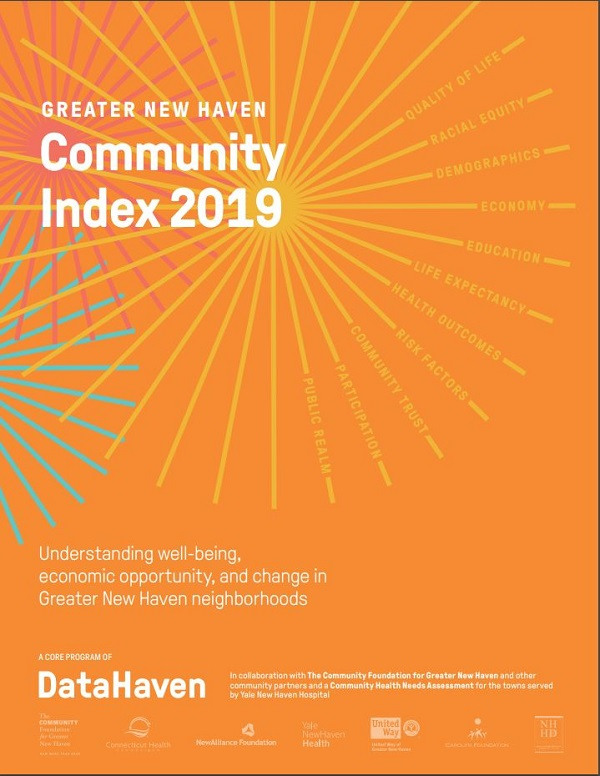New Greater New Haven Community Index 2019 Examines Regional Well-being and Economic Opportunity
The report Greater New Haven Community Index 2019: Understanding Well-Being, Economic Opportunity, and Change in Greater New Haven Neighborhoods provides information not otherwise available at a local level, such as respondents' views on effectiveness of local government, financial security, access to resources and basic needs, transportation, and other social and economic issues.
 |
 |
PRESS RELEASE
DataHaven
The Community Foundation for Greater New Haven
City of New Haven
Contact: Mark Abraham, Executive Director, 203-500-7059, info@ctdatahaven.org
New Haven, Conn. (October 31, 2019) - The report Greater New Haven Community Index 2019: Understanding Well-Being, Economic Opportunity, and Change in Greater New Haven Neighborhoods was published today by DataHaven and a team of regional foundations, including The Community Foundation for Greater New Haven, hospitals, government agencies, and community organizations. Widely used by public and private organizations throughout the region, the Community Index is a comprehensive, 120-page report with over 85 data graphics that describe the communities and neighborhoods that make up the Greater New Haven region, and uncover the opportunities and issues facing our area.
 |
The Greater New Haven Community Index 2019 is available for the public to download and read at http://ctdatahaven.org/reports/greater-new-haven-community-index. It serves as an update and expansion of the Greater New Haven Community Index 2013 and 2016 reports. In 2019, DataHaven has also made similar reports available for other parts of the state.
The DataHaven report is based on federal and statewide data sources, including the 2015 and 2018 DataHaven Community Wellbeing Survey, which conducted live interviews with over 32,000 randomly-selected adults throughout Connecticut last year and weighted the survey responses to be representative of adults living within individual municipalities throughout the state. Survey responses provide further context to population change, health, early childhood, youth and education, economic opportunity, and civic engagement in the region. The survey provides information not otherwise available at a local level, such as respondents' views on effectiveness of local government, financial security, access to resources and basic needs, transportation, and other social and economic issues.
Insights from the report are summarized visually in a "visual appendix" at the front of the report, a copy of which is attached here. Key findings include:
- Compared to the US and other metropolitan areas, Greater New Haven scores high on community well-being. The DataHaven Community Index score, constructed based on a variety of quality of life, health, and economic factors, would place the Greater New Haven area as the 17th highest-scoring area among the nation's 107 largest metropolitan regions.
- The Community Index score has improved by 12 percent since 2012 as the result of continued economic recovery after the Great Recession, particularly in measures such as unemployment and the expansion of health insurance coverage. Similarly, scores for the state and nation improved by 11 and 12 percent, respectively. Within the New Haven area, scores improved by 17 percent for the city of New Haven, 12 percent for the city's outer suburban towns, 11 percent for Hamden, 6 percent for West Haven, and 5 percent for East Haven.
- The report covers demographic change and economic opportunity in great detail.
- Population trends in Greater New Haven show diversity increasing.
- The nonwhite population has doubled since 1990 and the white population has decreased.
- The immigrant population has doubled since 1990. Thirteen-percent of the region's residents are immigrants.
- In most towns, particularly the outer ring suburbs, the median age is rising.
- Economic opportunity has improved since the Great Recession but varies widely.
- In New Haven, 30 percent of adults are underemployed - either without a job or limited to part-time work, and less than 4 in ten adults feel the area has good opportunities for employment.
- In the outer suburban towns, comparatively, 10 percent of adults are underemployed and more than 6 in ten are optimistic about the area's employment opportunities.
- Population trends in Greater New Haven show diversity increasing.
- The report also covers health in detail, as it serves as a health assessment for area health departments and health care institutions.
- Some community health insights and priorities for residents in the Greater New Haven (GNHV) region:
- Cancers and infant/fetal mortality resulted in the most years of potential life lost from 2010-14
- Fentanyl was present in 51% of drug overdose deaths in 2018, which is a 3.8-times increase from 2015
- Food and transportation insecurity were two major contributors to frequent users of the ER in 2018
- Overall estimated life expectancy for New Haven was 78.2 years and 79.8 years for GNHV in 2010-15
- 12% of GNHV and 19% of New Haven residents did not have a primary care medical home in 2018
- From 2006-10 to 2011-15, there was a 14% decrease in low birthweight and a 5% decrease in non-adequate prenatal care in New Haven
- The report concludes with a discussion of civic life, including measures of public space and infrastructure, municipal financing, and participation in government.
- Wealthier suburbs net more money from property values, spend more per-capita on public services and education and have residents with higher satisfaction rates with their community resources than the inner ring towns and New Haven.
- Seventy-three percent of the adults feel Greater New Haven is a good place to raise kids.
"The importance of the Community Index cannot be overstated, for it provides our community with a common understanding of how and in what ways our community is changing. The report is an invaluable resource for everyone with an interest in making Greater New Haven a place of opportunity for all present and future residents," said The Community Foundation for Greater New Haven President and CEO Will Ginsberg.
"The Community Index is an indispensable resource for the health department, city government, community partners/organizations, and the city's residents. It guides the region's community health improvement plan, research, project and outreach planning, grant procurement, data requests, and much, much more. The Index is and has been one of the principal documents directing past, present, and future work within the city to ensure and advocate for the health and well-being of all New Haven residents," said City of New Haven Health Department Epidemiologist Brian Weeks.
"The comprehensive, detailed, regional assessment built into the 2019 Community Index provides insight, supported by data, about the strengths we have to boast about here in New Haven, and also the challenges and obstacles we face while working to build on those strengths," New Haven Mayor Toni N. Harp said. "It also serves as a roadmap and milepost, informing decisions as we navigate both the short-term and longer-term future, and quantifying progress along the way."
Events and Outreach
To ensure accessibility of the report, findings and graphics from the report are being shared throughout this year at various community events, including The Community Foundation 2019 convening, "Creating a Future of Opportunity through Inclusive Growth," City of New Haven Community Forums, presentations to all of the New Haven Community Management Teams, briefings for mayors and first selectmen in the region, events at local libraries and schools, lectures at area universities, and other data workshops.
About the Report
The Community Foundation for Greater New Haven, Yale New Haven Health, City of New Haven, United Way of Greater New Haven, NewAlliance Foundation, and Connecticut Health Foundation were among the funders and supporters of the Greater New Haven Community Index 2019. Over 100 organizations throughout Connecticut supported the 2015 and 2018 DataHaven Community Wellbeing Survey, which is a major element of the Community Index 2019.
